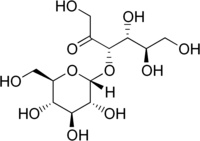Turanose: Difference between revisions
Content deleted Content added
m r2.7.1) (Robot: Adding fa:تورانوس |
No edit summary |
||
| (12 intermediate revisions by 12 users not shown) | |||
| Line 1: | Line 1: | ||
{{chembox |
{{chembox |
||
| Verifiedfields = changed |
|||
| ⚫ | |||
| Watchedfields = changed |
|||
|Name = <small>D</small>-Turanose |
|||
| ⚫ | |||
| ⚫ | |||
| Name = {{sm|d}}-Turanose |
|||
| ⚫ | |||
| ⚫ | |||
| ⚫ | |||
| ⚫ | |||
|OtherNames=α-D-glucopyranosyl-(1→3)-α-D-fructopyranose |
|||
| IUPACName = α-<small>D</small>-glucopyranosyl-(1→3)-α-<small>D</small>-fructofuranose |
|||
| ⚫ | |||
| OtherNames = |
|||
| ⚫ | |||
| ⚫ | |||
| ⚫ | |||
| ⚫ | |||
| ⚫ | |||
| ⚫ | |||
| CASNo=547-25-1 |
| CASNo=547-25-1 |
||
| UNII_Ref = {{fdacite|correct|FDA}} |
|||
| ⚫ | |||
| UNII = 6D600ARY3R |
|||
| ⚫ | |||
| ⚫ | |||
| ⚫ | |||
| ChemSpiderID_Ref = {{chemspidercite|changed|chemspider}} |
|||
| ChemSpiderID = 4574343 |
|||
| ⚫ | |||
| InChI = 1/C12H22O11/c13-1-4(16)7(18)11(5(17)2-14)23-12-10(21)9(20)8(19)6(3-15)22-12/h4,6-16,18-21H,1-3H2/t4-,6-,7-,8-,9+,10-,11-,12-/m1/s1 |
|||
| InChIKey = RULSWEULPANCDV-PIXUTMIVBJ |
|||
| StdInChI_Ref = {{stdinchicite|changed|chemspider}} |
|||
| StdInChI = 1S/C12H22O11/c13-1-4(16)7(18)11(5(17)2-14)23-12-10(21)9(20)8(19)6(3-15)22-12/h4,6-16,18-21H,1-3H2/t4-,6-,7-,8-,9+,10-,11-,12-/m1/s1 |
|||
| StdInChIKey_Ref = {{stdinchicite|changed|chemspider}} |
|||
| StdInChIKey = RULSWEULPANCDV-PIXUTMIVSA-N |
|||
| ⚫ | |||
}} |
}} |
||
|Section2={{Chembox Properties |
| Section2 = {{Chembox Properties |
||
| |
| Formula=C<sub>12</sub>H<sub>22</sub>O<sub>11</sub> |
||
| |
| MolarMass=342.30 g/mol |
||
| |
| Appearance= |
||
| |
| Density= |
||
| |
| MeltingPt= |
||
| |
| BoilingPt= |
||
| |
| Solubility= |
||
}} |
}} |
||
|Section3={{Chembox Hazards |
| Section3 = {{Chembox Hazards |
||
| |
| MainHazards= |
||
| |
| FlashPt= |
||
| AutoignitionPt = |
|||
| Autoignition= |
|||
}} |
}} |
||
}} |
}} |
||
'''Turanose''' is a [[Redox|reducing]] [[disaccharide]]. The |
'''Turanose''' is a [[Redox|reducing]] [[disaccharide]]. The {{sm|d}}-isomer is naturally occurring. Its systematic name is α-{{sm|d}}-glucopyranosyl-(1→3)-α-{{sm|d}}-fructofuranose. It is an analog of [[sucrose]] not [[Metabolism|metabolized]] by [[Vascular plant|higher plants]], but rather acquired through the action of sucrose transporters for intracellular [[carbohydrate]] signaling. In addition to its involvement in signal transduction, {{sm|d}}-(+)-turanose can also be used as a carbon source by many organisms including numerous species of [[bacteria]] and [[fungus|fungi]].<ref>{{cite journal | author = Sinha, A.K.| title = Metabolizable and non-metabolizable sugars activate different signal transduction pathways in tomato | journal = Plant Physiol | volume = 128 | pages = 1480–1489 | year = 2002 | doi = 10.1104/pp.010771 | pmid = 11950996 | issue = 4 | pmc = 154275|display-authors=etal}}</ref><ref>{{cite journal | author = Gonzali, S.| title = A turanose-insensitive mutant suggests a role for WOX5 in auxin homeostasis in Arabidopsis thaliana | journal = Plant J | volume = 44 | pages = 633–645 | year = 2005 | doi = 10.1111/j.1365-313X.2005.02555.x | pmid = 16262712 | issue = 4|display-authors=etal| doi-access = free }}</ref><ref>{{cite journal | author = Sivitz, A.B.| title = Arabidopsis sucrose transporter AtSUC9. High-affinity transport activity, intragenic control of expression, and early flowering mutant phenotype | journal = Plant Physiol | volume = 143 | pages = 188–198 | year = 2007 | doi = 10.1104/pp.106.089003 | pmid = 17098854 | issue = 1 | pmc = 1761979|display-authors=etal}}</ref><ref>{{cite journal | author = Loreti, E.| title = Glucose and disaccharide-sensing mechanisms modulate the expression of α-amylase in barley embryos | journal = Plant Physiol | volume = 123 | pages = 939–948 | year = 2000 | doi = 10.1104/pp.123.3.939 | pmid = 10889242 | issue = 3 | pmc = 59056|display-authors=etal}}</ref><ref> [http://www.sigmaaldrich.com/catalog/search/ProductDetail/SIGMA/T2754 D-Turanose] at [[Sigma-Aldrich]]</ref> |
||
==References== |
==References== |
||
| Line 38: | Line 51: | ||
[[Category:Disaccharides]] |
[[Category:Disaccharides]] |
||
[[ca:Turanosa]] |
|||
[[es:Turanosa]] |
|||
[[fa:تورانوس]] |
|||
[[fr:Turanose]] |
|||
[[gl:Turanosa]] |
|||
[[ja:ツラノース]] |
|||
Latest revision as of 15:27, 17 June 2023

| |
| Names | |
|---|---|
| IUPAC name
α-D-glucopyranosyl-(1→3)-α-D-fructofuranose
| |
| Systematic IUPAC name
(3S,4R,5R)-1,4,5,6-tetrahydroxy-3-[(2R,3R,4S,5S,6R)-3,4,5-trihydroxy-6-(hydroxymethyl)oxan-2-yl]oxyhexan-2-one | |
| Identifiers | |
3D model (JSmol)
|
|
| ChemSpider | |
| ECHA InfoCard | 100.008.108 |
| MeSH | turanose |
PubChem CID
|
|
| UNII | |
CompTox Dashboard (EPA)
|
|
| |
| |
| Properties | |
| C12H22O11 | |
| Molar mass | 342.30 g/mol |
Except where otherwise noted, data are given for materials in their standard state (at 25 °C [77 °F], 100 kPa).
| |
Turanose is a reducing disaccharide. The d-isomer is naturally occurring. Its systematic name is α-d-glucopyranosyl-(1→3)-α-d-fructofuranose. It is an analog of sucrose not metabolized by higher plants, but rather acquired through the action of sucrose transporters for intracellular carbohydrate signaling. In addition to its involvement in signal transduction, d-(+)-turanose can also be used as a carbon source by many organisms including numerous species of bacteria and fungi.[2][3][4][5][6]
References[edit]
- ^ Turanose - Compound Summary, PubChem
- ^ Sinha, A.K.; et al. (2002). "Metabolizable and non-metabolizable sugars activate different signal transduction pathways in tomato". Plant Physiol. 128 (4): 1480–1489. doi:10.1104/pp.010771. PMC 154275. PMID 11950996.
- ^ Gonzali, S.; et al. (2005). "A turanose-insensitive mutant suggests a role for WOX5 in auxin homeostasis in Arabidopsis thaliana". Plant J. 44 (4): 633–645. doi:10.1111/j.1365-313X.2005.02555.x. PMID 16262712.
- ^ Sivitz, A.B.; et al. (2007). "Arabidopsis sucrose transporter AtSUC9. High-affinity transport activity, intragenic control of expression, and early flowering mutant phenotype". Plant Physiol. 143 (1): 188–198. doi:10.1104/pp.106.089003. PMC 1761979. PMID 17098854.
- ^ Loreti, E.; et al. (2000). "Glucose and disaccharide-sensing mechanisms modulate the expression of α-amylase in barley embryos". Plant Physiol. 123 (3): 939–948. doi:10.1104/pp.123.3.939. PMC 59056. PMID 10889242.
- ^ D-Turanose at Sigma-Aldrich
